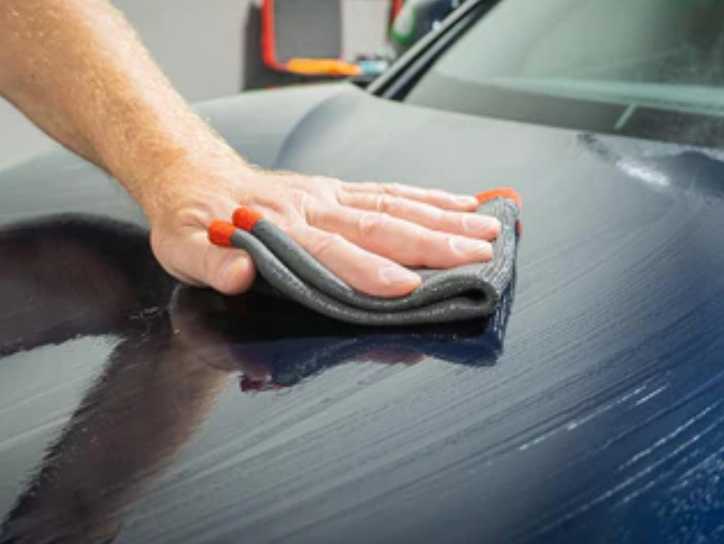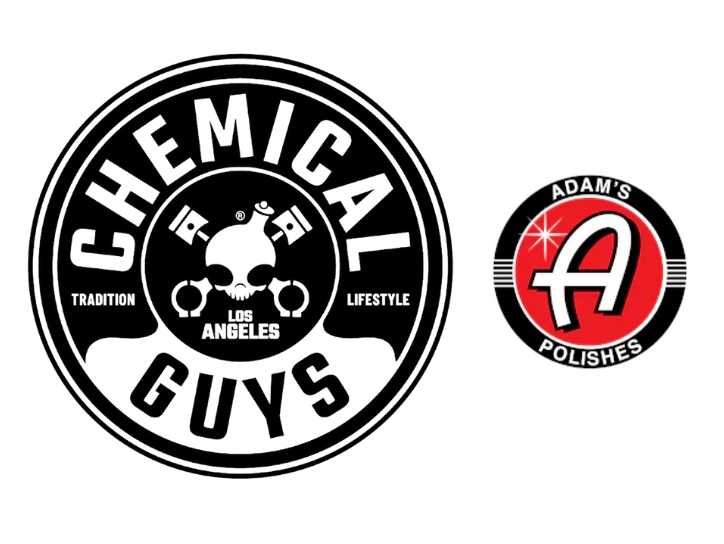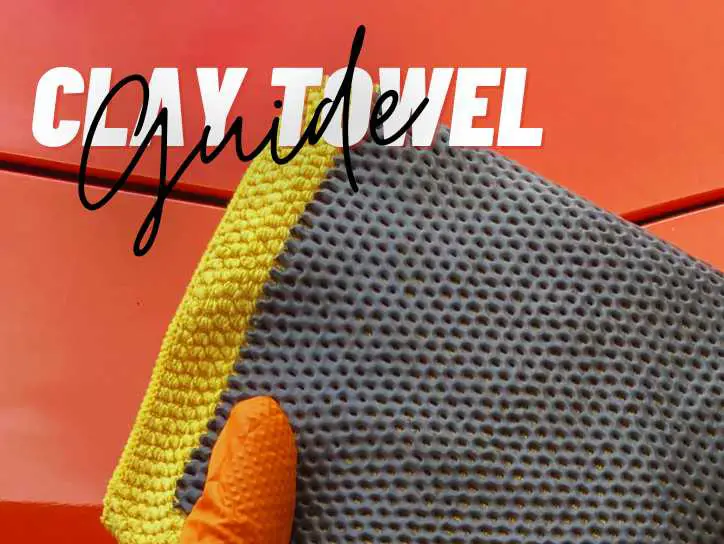Meet the clay towel – your car’s magic cleaner.
It’s like a regular towel with long-last shining.
In a nutshell, it wipes away all the dirt, leaving your ride shining like never before. Ready for the magic? Let’s dive in.
What is a Clay Towel?

A clay towel is a detailing microfiber fabric designed to enhance the appearance of automotive surfaces. Unlike traditional clay bars, a clay towel combines the effectiveness of clay with the convenience of a towel. It is crafted with a specialized clay-like material on one side, allowing for the removal of contaminants from a vehicle’s paint, glass, and metal surfaces.
Benefits of Using a Clay Towel over a Clay Bar
As a beginner, choosing a clay towel offers several advantages in automotive detailing. Let’s discuss them in detail, shall we?
1. Offers Ease of Use
Clay towels are more user-friendly, making them accessible for both professionals and DIY enthusiasts/car owners. Their design is kinds of similar to a regular towel, allowing for a more comfortable and intuitive application.
2. Offer Time Efficiency
Clay towels cover larger surface areas, making the detailing process quicker compared to clay bars. The larger surface contact means you can complete the job in less time without compromising results.
3. Reduced Work Fatigue
The ergonomic design of clay towels reduces hand fatigue during cleaning, enhancing overall detailing comfort.
4. Offers Versatility
Clay towels can be used on various surfaces, including paint, glass, and metal, providing a versatile solution for different detailing needs. They adapt well to intricate areas, such as curves and contours, ensuring a thorough cleaning.
5. Minimized Risk of Scratches
The flat, smooth surface of clay towels minimizes the risk of scratching the vehicle’s paint compared to the traditional clay bar. The even pressure distribution across the towel helps maintain the integrity of the surface being treated.
6. Offers Reusability
Clay towels are often reusable, allowing for multiple applications before needing replacement. This reusability factor contributes to cost-effectiveness over time.
7. Easy Maintenance
Cleaning and maintaining clay towels are straightforward, requiring basic steps to ensure their longevity. Unlike clay bars, there’s no need for constant reshaping or constant monitoring of the clay’s condition.
8. Adaptability to Lubricants
Clay towels can work effectively with various types of lubricants, providing flexibility in choosing the right product for different applications. This adaptability enhances the overall performance of the detailing process.
9. Cost-Effective Solution
While the initial investment might be slightly higher, the reusability and efficiency of clay towels contribute to long-term cost savings.
10. Accessibility for Beginners
Clay towels are more forgiving for beginners, offering a smoother learning curve compared to traditional clay bars. Clay Towel allows individuals new to detailing to achieve professional-looking results with greater ease.
How Does a Clay Towel Work?

Clay towels operate by utilizing a specialized clay-like material on one side. This material is designed to grab and remove contaminants from various surfaces, including paint, glass, and metal. Unlike traditional clay bars, clay towels cover larger areas, allowing for a more efficient detailing process. The surface contaminants adhere to the clay material, leaving the treated surface smoother and free from impurities.
Clay Towel vs. Traditional Clay Bar
In comparing clay towels to traditional clay bars, the primary difference lies in their form and application. Clay towels, like regular towels, are user-friendly and cover more significant surface areas, making them time-efficient. Unlike clay bars, which require constant reshaping and can be challenging for beginners, clay towels provide a smoother learning curve and reduce the risk of marring the paint. I’ve also compared clay towels and bars in detail.
Clay Towel Price
A basic clay towel price starts from $5 and goes up to $60 or even higher. This price depends on the brand, size, and your location and the specific product features.
Steps to Use a Clay Towel on Vehicle’s Surface
- Prepare the Surface: Thoroughly wash and dry the vehicle to remove loose dirt and contaminants from the surface.
- Select a Suitable Lubricant: Choose a compatible lubricant for the clay towel application. A lubricant ensures smooth gliding and prevents scratches during the detailing process.
- Apply Lubricant: Spray or apply the chosen lubricant generously on the section of the vehicle you plan to work on. Ensure even coverage.
- Fold and Knead the Clay Towel: If the clay towel is large, fold it to a manageable size. Knead the clay material gently to expose a clean section for effective use.

Note: Follow the steps in the above image. This will let you use a towel 4 times without compromising the finishing.
- Gently Glide the Clay Towel: With light to moderate pressure, glide the clay towel over the lubricated surface. Allow the clay to pick up contaminants, making the surface smoother.
- Regularly Inspect the Clay Towel: Check the clay towel regularly for accumulated contaminants. If the surface becomes heavily soiled, refold and knead the towel to expose a clean area.
- Repeat the Process: Continue the process, working in small sections, until the entire desired surface is treated. Ensure thorough coverage for optimal results.
- Wipe the Surface: Once a section is complete, wipe the treated surface with a clean, dry microfiber cloth to remove any remaining lubricant and reveal a smooth finish.
- Inspect the Results: Inspect the treated surface to ensure that contaminants have been effectively removed, leaving a clean and polished appearance.
Note: If certain areas still have contaminants, repeat the process as needed until the entire vehicle surface meets the desired level of cleanliness and smoothness.
Different Types of Clay Towels
- Synthetic Clay Towels: A Synthetic clay towel is crafted from engineered materials that mimic the properties of natural clay. These towels offer consistent performance and durability. They are often softer than traditional clay bars, providing a gentler approach to detailing.
- Nanoskin Clay Towels: Nanoskin clay towels incorporate nanotechnology, featuring ultra-fine abrasive particles on the surface for enhanced cleaning. Nanoskin is known for its effectiveness in removing contaminants and superior cleaning ability while maintaining surface safety.
- Hybrid Clay Towels: Hybrid clay towels combine synthetic materials with traditional clay components, creating a versatile and efficient detailing tool. These towels often exhibit the best of both properties, providing the durability of synthetic materials and the contaminant removal capability of traditional clay.
Steps to Choose the Right Clay Towel for Your Needs
- Purpose: Define whether you need the clay towel for polishing, waxing, or removing contaminants.
- Types: Explore traditional clay bars, clay mitts, and clay towels to understand their differences.
- Material: Choose between synthetic or a mix of synthetic and natural materials.
- Size: Select a size based on your vehicle and specific detailing needs.
- Reviews: Read online reviews to gauge the real-world performance of different towel brands.
- Compatibility: Ensure the clay towel works well with your chosen detailing products.
- Budget: Set a budget and explore options within that range.
- Brand: Stick to reputable brands known for quality automotive care products.
- Recommendations: Seek advice from experienced detailers, mechanics or enthusiasts for specific product recommendations.
Clay Towel Maintenance and Cleaning
Please follow the given tried and tested ways:
Steps to Clean a Clay Towel
- Rinse: Immediately rinse the clay towel under running water to remove loose contaminants.
- Soak and Agitate: Soak the towel in warm water, then gently agitate to loosen the remaining debris.
- Clean with Mild Soap: Use a mild soap solution to hand wash the clay towel, removing contaminants.
- Rinse Thoroughly: Rinse the towel thoroughly under running water to remove soap and contaminants.
- Air Dry and Store: Allow the clay towel to air dry completely and store it in a cool, dust-free environment after each use.
How to Store Clay Towel?
To avoid drying, store the clay towel in a sealed container or wrap it in a microfiber cloth. Keeping it moist ensures its pliability for future use.
Note: Store the towel in a cool, dry place away from direct sunlight. Extreme temperatures can affect the clay’s composition and performance.
Common Signs to Replace Your Clay Towel
If the clay towel is no longer effectively removing contaminants or feels less smooth during application, it may be time to replace it. It’s also important to check for signs of excessive wear, such as tearing or thinning of the clay material. A compromised towel may cause scratches on the surface.
Tips and Tricks for Optimal Clay Towel Usage
Using a clay towel can be an effective way to remove contaminants for beginners or DIY enthusiasts. Follow the given tips for optimal clay towel usage:
- Lubricate generously
- Inspect surfaces before use
- Work in sections
- Keep towel moist
- Rotate or fold regularly
- Apply moderate pressure
- Use clay lubricant
- Post-clay inspection
- Store properly
- Regular maintenance
Note: Always refer to the manufacturer’s instructions for the specific clay towel you are using, as different products may have slightly different recommendations.
List of Most Reputed Clay Towels Brands

Below is a list of some well-known clay towel brands:
- Meguiar’s: It’s a renowned brand in the automotive detailing industry and offers a variety of detailing products, including clay towels.
- Chemical Guys: Chemical Guys is known for its extensive line of car care and detailing products, and it provides clay towels for surface decontamination.
- Nanoskin: The brand specializes in surface preparation and protection products, including clay towels designed for decontaminating automotive surfaces.
- Adam’s Polishes: Adam’s Polishes is a popular brand offering a wide range of car care products, and they have clay towels in their lineup for paint decontamination.
- Autoglym: Autoglym is a well-established brand that provides various car care solutions, including clay towels for removing contaminants from paint surfaces.
FAQs
Can clay towels scratch the surface of a car?
Clay towels are designed to be gentle on a car’s surface and are less likely to cause scratches compared to traditional clay bars. However, it’s crucial to use them properly and ensure that both the towel and the surface are adequately lubricated to minimize the risk of scratching.
Are clay towels safe for all types of paint finishes?
Clay towels are generally safe for use on all types of automotive paint finishes, including clear coats. However, it’s advisable to test a small, inconspicuous area first to ensure compatibility and to follow the manufacturer’s recommendations.
How often should you use a clay towel on your car?
The frequency of clay towel usage depends on factors such as environmental conditions, driving habits, and the overall condition of the car’s paint. As a general guideline, using a clay towel once or twice a year is often sufficient for most vehicles.
Can clay towels be used on surfaces other than car paint?
Clay towels can be used on various automotive surfaces, including glass, chrome, and plastic. However, it’s essential to read the product instructions and ensure compatibility with different surfaces.
Are clay towels reusable?
Yes, clay towels are typically reusable. After use, it’s important to clean the towel thoroughly to remove the accumulated contaminants. Depending on the extent of use and the level of contamination, clay towels may be effective for multiple applications.
How should clay towels be stored to maintain their effectiveness?
To maintain the effectiveness of clay towels, it’s recommended to store them in a cool, dry place, away from direct sunlight. Proper storage helps prevent the clay-like material from deteriorating and ensures the towel remains ready for future use.
Do clay towels replace traditional clay bars in car detailing?
Clay towels are considered an alternative to traditional clay bars, offering similar contaminant removal capabilities with the added convenience of a towel format. The choice between the two often depends on personal preference and specific detailing needs.
Can clay towels be used with any lubricant, or is a specific product recommended?
While some clay towels may work with various lubricants, it’s generally recommended to use the specific lubricant recommended by the clay towel manufacturer. Using the right lubricant ensures optimal performance and reduces the risk of scratching.
Are there different grades or levels of aggressiveness for clay towels?
Yes, clay towels come in different grades or levels of aggressiveness. Some are designed for light contamination, while others are more aggressive and suitable for heavier contamination. Choosing the right grade depends on the condition of the vehicle’s paint.
Can clay towels be used on matte paint finishes?
It’s crucial to check with the manufacturer to ensure that the clay towel is safe for use on matte paint finishes. Some products may be specifically designed for matte surfaces, while others could potentially alter the appearance.
Do clay towels leave behind any residue on the car’s surface?
High-quality clay towels are designed to leave minimal to no residue on the car’s surface. However, it’s recommended to inspect the paint after claying and, if necessary, follow up with a quick detailer to ensure a clean and residue-free finish.
Can clay towels remove water spots from the car’s paint?
While clay towels are primarily designed for removing embedded contaminants, they may help reduce the appearance of water spots. For more stubborn water spots, additional detailing techniques and products may be necessary.
Are there any special considerations for using clay towels on black cars?
Black cars tend to show imperfections more prominently, so it’s important to use a light touch when using clay towels. Additionally, choosing a high-quality clay towel and ensuring proper lubrication can help minimize the risk of swirl marks on black paint.
Conclusion
A clay towel offers car owners an effective solution for removing contaminants, enhancing paint finish, and maintaining vehicle aesthetics.
Their versatility, ease of use, and affordability make them a valuable addition to any detailing toolkit.
Whether you’re a seasoned detailer or a car enthusiast, investing in a quality clay towel can contribute to the overall beauty and longevity of your vehicle’s exterior.
Do share your thoughts on the clay towel—your suggestions and experiences matter.

